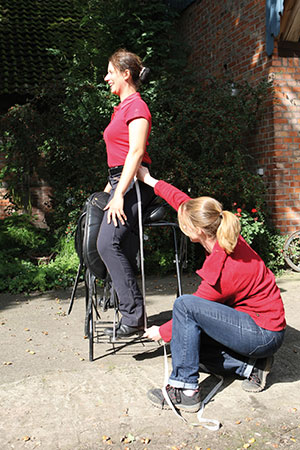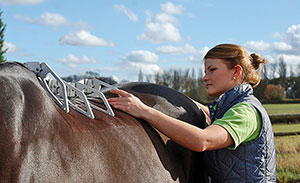
Measuring the rider for proper saddle fit.
This being the Christmas season with presumably at least some riders hoping for a saddle under the tree I thought it would be worth repeating some key points I have previously touched on. In essence you may use the “9 points of saddle fit as a guide”, but here are a few extra pointers.
The art of fitting a saddle to both horse and rider is something which is not explained in a few sentences; indeed something new can be learned every day, as each client brings with him or herself something different to consider. It’s not rocket science, but it is a science, combined with the artistry of actually building the saddle. It is important to work closely with veterinarians and physiotherapists and other equine professionals to constantly ensure the most optimal combination of horse, rider and saddle. Anatomical considerations of both horse and rider are a key determinant in how to choose the correct saddle. Hopefully if you have such a generous benefactor in your life who is thinking of getting you a saddle for Christmas they will know to involve both you and your horse and not just go for a ‘pretty saddle’. (Which I have to say – unfortunately many of them are, including one really high end prestigious company whose saddles are not really all that equine-friendly at the end of the day!)
“A well-designed and correctly fitted saddle is vital to the performance of both horse and rider. Whatever type of saddle is chosen, the main consideration is that it should fit both horse and rider. To check that it does so, not only must the rider sit on it, but it should be put on the horse and its fit must be studied before it is bought. A badly fitting saddle not only causes discomfort to the horse and rider, but can actually stop a horse from moving properly. The tree and panels of a saddle should be chosen to fit the horse, and the seat and flap length should be chosen to fit the rider.” (Julie Richardsen’s Horse Tack (Complete Equipment for Riding and Driving). (New York, 1981). But that’s not all, as I have written about previously – there are so many other parts of the saddle that need to be taken into consideration when ensuring proper fit and comfort for both horse and rider.
The proper way to measure the seat size of an English saddle is diagonally from either saddle nail, on the side of the pommel, to the centre of the cantle. Adult seat sizes vary from 16″ to 19″, with 17″ to 17 1/2″ being the most common – but even these are variable, as the position of these nails can be pretty arbitrary, depending on the mood of the saddler on any given day. The rider should try out several makes to see which feels most comfortable, because even half an inch can make a difference. Different makes of the same size can also feel differently. It’s like buying shoes – you have to try them on and walk in them to see what actually fits.
In addition, the saddle trees vary in width at the twist (where the tree is between the upper inner thighs), the deepest point, and in the amount of seat foam, which is essentially the padding. There are of course different “fads” and popular riders which influence choices in forward or rear seat, deepest points, etc. When you have found a model which feels comfortable to you, it must be taken to the horse to see how it fits on its back. You do know that it is important that the saddle feel comfortable and fit the rider correctly, because if this is not the case, the rider’s discomfort will translate down to the horse, no matter how well the saddle fits the horse! Saddle size must take into consideration not only the size for the rider, but also the length of the horse’s back. Much can be done with panels to ensure that comfort of the horse is paramount – for instance, if you have a larger person (with an 18” saddle seat) and a very short-backed horse, the panels may be shortened to ensure that the panels do not hit any reflex points which could result in bucking or pain for the horse’s back. The panels should not go past the 18th lumbar vertebrae.
Flap size and position must also be considered – this is why certain measurements on the rider are important to ensure that the leg is properly “covered” by the flap and positioned properly.

Measuring the three dimensional shape of the horse’s back with the Arc Device™.
The correct positioning on the horse is vital. The saddle should be placed on the horse’s back at the withers and then pushed back (to make sure the hairs are smoothed down). The tree points should be directly behind the shoulder blades. The centre of the saddle should lie horizontally to the ground to ensure proper positioning of the deepest point.
When viewed from behind it is easy to see if the saddle is straight. Most horses are not muscled evenly, and the padding of the saddle can be adjusted to reflect these differences. Between the withers and the pommel there should be two to three fingers clearance all around, since this space will be decreased with the weight of the rider, and the pull of the girth. The saddle should at no point touch the backbone along the whole of its length. The gullet channel should be wide enough in order not to interfere with the spinal processes or the dorsal ligament system of the horse’s back. Ensure it doesn’t rock or bridge.
The rider should then get on to see if his or her seated position is correct – for instance, for dressage the shoulders, hips and heels should be in one straight vertical line. Riders may find themselves sitting too far back in the saddle. An attempt to alleviate this is usually done with a keyhole (or other) pad, which in effect does nothing, because the rubber compresses so tightly as to have an almost non-existent effect. In addition, the rubber gives one the feeling of “swimming” on the horse’s back. This situation can be remedied with proper re-stuffing or a panel wedge in the event that greater height is required to bring the rider more forward in the position. Proper stuffing does not always mean more stuffing. The panel is essentially a cushion and too much stuffing (which can be as bad as too little) can harder the panel to the extent of losing the cushioning effect. With a properly fitting saddle you should only need a thin, quilted cotton pad – to protect the leather, nothing more!
Most new saddles are filled fairly loosely with a wool/synthetic mix, which takes about six months of regular riding to settle onto the shape of the horse’s back. At this time the first re-stuffing should be done, with check-ups about every two years after. Of course, foam and felt panels generally cannot be refitted – they either fit or they don’t and that’s where pads will come in hand. There are many external influences which can play a role in determining how well your saddle fits and continues to fit at any time. Also keep in mind that what fits while the horse is standing still may not work once he starts moving.
Unless the rider has a definite intention to specialize in a particular area of equestrianism, a general purpose saddle is probably the best answer. However, personal preferences, body size as well as type of horse, should all be considered when buying a saddle.
Basically – both you and your horse need to feel comfortable, be balanced, and perform optimally with the choice you make. It boils down to personal preference of what feels good for you and works for your horse – nothing more scientific than that!
I hope Santa is good to you and you get what you want and need – and then find yourself a competent fitter to ensure that the saddle continues to fulfil its duty to you and your horse!
Merry Christmas and a safe and happy holiday season!
~ Jochen Schleese CMS, CSFT, CSE, courtesy of Saddlefit 4 Life
